When I began storing food just before Y2K, there was much controversy and uncertainty about this subject. Most who wrote about it were new at it themselves and had no long term experience to draw upon thereby what they were writing about was just a guess. Because of their guesses I made some mistakes in the beginning but, through my own trial and error and not giving up, got me on the right track.
It's not as difficult as you think, just two rules for food storage.
Rule #1, Keep it very simple with minimal varieties!
Rule #2, Store only what you've already tested, eat and know how to prepare.
Another confusing area about food storage is we’ve all heard about long term and short term but. What are they and how long is each and generally what kind of food is stored in each? Here’s what worked out for me:
Short Term Storage:
- Up to 2 years shelf-life.
- Virtually all foods in your supermarket fit this 2 year time frame.
- This is the food that's in your everyday pantry, just more of it.
- It is can, pouched, bagged or boxed foods including your home canned food.
- The source for this food is your everyday supermarket.
- There should not be any foods in Short Term Storage that requires freezing or needs refrigeration because you cannot ever count on having dependable grid electricity in troubled times.
- For Short Term storage there's no need for buying kit buckets of food, MRE's or other specialty survival foods.
- All can or home canned foods needs to be protected from freezing.
Mid-Term Storage:
- Up to 10 years shelf-life.
- Most all #10 cans of dehydrated or freeze dried foods.
- Most all pouched foods/meals like the Mountain House brand.
- MRE’s (Meals Ready to Eat).
- Kit Buckets of food, like the Mountain House 72 hour kit/bucket.
Long Term Storage:
- Up to 30 years shelf-life.
- Any purchased foods with a declared shelf-life of up to 30 years.
- Typically this is all bulk purchased dry foods like; wheat, beans, lentils, rice, barley, pasta, etc.
- It requires being sealed in Mylar Bags with Oxygen Absorbers.
- Included are ‘some’ #10 cans of dehydrated or freeze dried food, verify shelf-life before storing.
Additional Information:
Stocking commercially canned foods, long term food storage and home canning always raise the same question. What is the shelf life? I look to University Extension Services for the most accurate research and tested methods. The links below will help answer this question with tested fact. Enjoy and be safe with your food storage and canning!
The shelf life paragraph below is from the Utah State University Cooperative Extension
http://extension.usu.edu/foodstorage/htm/canned-goods/
Shelf Life:
As a general rule, unopened “Home canned foods” have a shelf life of one year and should be used before 2 years. “Commercially canned foods” should retain their “best quality” until the expiration code date on the can. This date is usually 2-5 years from the manufacture date. High acid foods usually have a shorter shelf life than low acid foods.
For emergency storage, commercially canned foods in metal or jars will remain safe to consume as long as the seal has not been broken. (That is not to say the quality will be retained for that long).
Foods “canned” in metal-Mylar®-type pouches will also have a best-if-used by date on them. The longest shelf life tested of this type of packaging has been 8-10 years (personal communication U.S. Military MRE’s). Therefore, storage for longer than 10 years is not recommended.
Here’s a few very good links for more qualified canning information.
Utah State University Cooperative Extension
http://extension.usu.edu/foodstorage/htm/canned-goods/
39 Food Specific PDF’s about canning are at this link plus other informative topics.
http://extension.usu.edu/htm/publications/by=category/category=319
National Center for Home Food Preservation. Lots of trustworthy information at this site.
http://www.uga.edu/nchfp/publications/publications_usda.html











